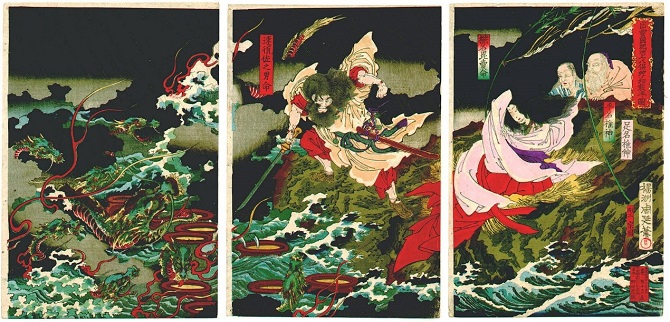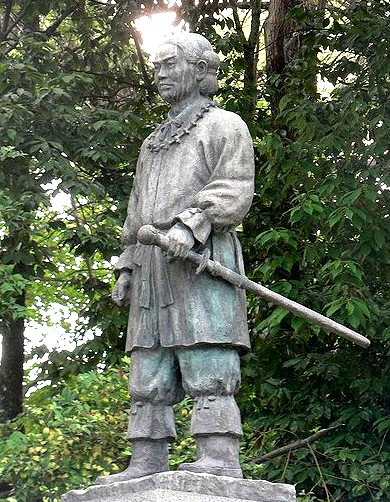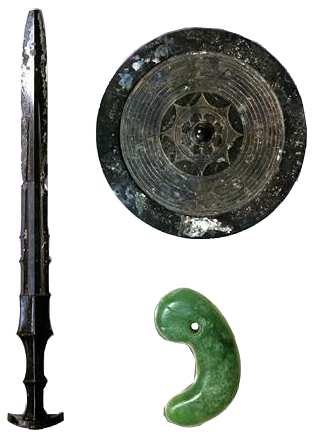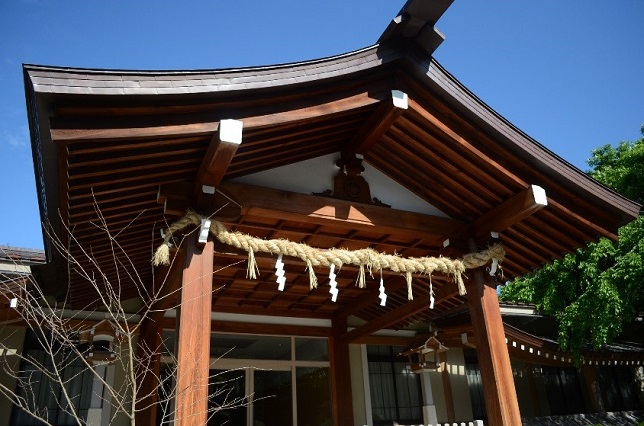
Susanoo slaying the Yamata-no-Orochi (by Toyohara Chikanobu, Public Domain)
One of the goals of our community content is to connect our players to For Honor via the many real world touchstones the game calls upon for inspiration. In this "Tale of Weapons" series of articles, we will explore legendary weapons that are either historical or mythological, which inspire our team's creation of the weapons wielded by the Knights, Vikings and Samurai of For Honor.
Most weapons covered in this series are a mix of historical facts and legends. In the case of the Kusanagi, this mysterious Japanese sword, the lines are even more blurred between fantasy and reality. According to the legend, Susanoo, the god of the sea and storms, had to fight the fearsome Yamata-no-Orochi, an eight-headed serpent (you guessed it, Orochi means “serpent”) that was ravaging a family. After elaborating a complex plan to slash each of the serpent’s heads, Susanoo finally defeated the monster and started chopping his tails. Inside the fourth tail, he discovered a beautiful sword he offered to his sister Amaterasu, goddess of the sun. This sword would then play an important role in shaping Japanese tradition.
The sword got passed from emperor to emperor throughout the years, and at some point ended up in Yamato Takeru’s possession, who is the son of the legendary Emperor Keiko who is said to have lived around 100 A.D.. During a hunting trip, Takeru was attacked by a rival who set a fire around him. The sword was so sharp that Takeru cut all of the flaming grass around him. He then discovered that the sword could control the wind according to the direction he swings it. He used this magic power to redirect fire at his rival and his men, and triumphed the battle. Takeru then gave the sword its current name Kusanagi-no-Tsurugi, which means “Grasscutter Sword”.

A statue of Yamato Takeru with the Kusanagi (public domain)
Fast forward to 688 A.D., and that’s where the line between history and fantasy gets even blurrier when the sword was blamed for the death of Emperor Temmu, who died of a mysterious illness. Kusanagi was then removed from the Imperial palace and taken to the Atsuta Shrine in Nagoya, where it’s considered one of the Three Sacred treasures of Japan, along with the Yata-no-Kagami (a mirror) and the Yasakani-no-Magatama (a jewel). To this day, these sacred items are still used during emperors’ private enthronement ceremonies. The public, though, has never been allowed to see them.

Artist’s impression of the Three Sacred Treasures of Japan: the Kusanagi, the jewel and the mirror (Public domain)
Because of its mythological component, there are not a lot of public records about the look and style of the sword, nor do we know who crafted it. According to Shinto priest Matsuoka Masanao, who actually saw the sword somewhere during the Edo Period (1603 – 1868), Kusanagi is about 82 cm long and the blade looks like a calamus leaf. The middle of the sword has a thickness from the grip of about 18 cm with an appearance of a fish spine. The sword was fashioned in a white metallic color and seemed to be in a very good condition even at that time. The sword was kept in a stone box inside a wooden box, and inside the stone box was a hollowed log of a camphor tree, acting as another box. The sword was gently placed on top of that. Besides that description, we don’t know much more about the sword’s appearance.

Atsuta Shrine in Nagoya, where the Kusanagi is kept (source: the.Firebottle on Flickr)
Now that’s where different stories about the fate of sword come up: some people believe the original sword was lost in the sea in the 12th century, after a battle between the two dominant clans of Japan, the Minamoto and the Taira. A Taira soldier tossed the weapon in the water to make sure the Minamoto clan don’t get their hands on it, so the sword then disappeared forever. In that case, the Kusanagi located at the Atsuta Shrine would be a copy. Another story tells that the original was recovered from the water, and the one sitting at the shrine is still the original.
In modern history, the current Emperor of Japan, Akihito, received the sword during his enthronement ceremony in 1989, but it remained under wraps and didn’t see the light of day. That was probably its latest appearance. A TV crew also went to Atsuta Shrine to film the sword, but they were turned away by the priests.
Whether the Kusanagi is real or not, it played a huge role in Japan’s mythology up to this day. References to the sword were made in many video games, in anime such as Naruto, in movies, not to forget the protagonist of Masamune Shirow’s masterpiece Ghost in the Shell was named after the sword.
More articles in “A Tale of Weapons”
A Tale of Weapons 1 - The Knights Durendal
A Tale of Weapons 2 - The Vikings Ulfberht
A Tale of Weapons 3 - The Samurais Honjo Masamune






